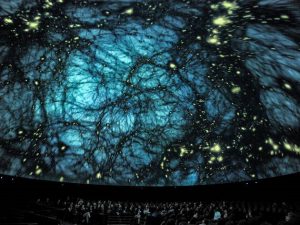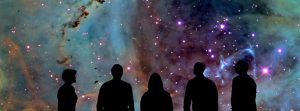
New Home for Astronomy
A New Home for Astronomy at U of T
New Facility would bolster existing efforts in research, teaching and public engagement
Modern digital projection technologies, such as World-Wide Telescope, enable exploration of the entire cosmos in real time, using data from real telescopes and space probes. (Credit: http://www.worldwidetelescope.org/)
After more than a century investigating distant galaxies, black holes, the structure of the universe, supernovae and gravitational waves, astronomers and astrophysicists at the University of Toronto’s St. George Campus are setting their sights on something a little closer to home.
Early planning has begun for a new building to harness the significant research and teaching capacities that have the University at the forefront of astronomical discovery in Canada.
The wish list for the new structure includes a mix of research facilities, classrooms, departmental offices, and a planetarium of up to 150 seats to facilitate the academic and research pursuits of the proposed joint occupants, and to support community outreach.
Our vision
The plan is for the new building to be located at 50 St. George Street. It will serve as an astronomy precinct on the St. George campus, bringing together under one roof the Department of Astronomy & Astrophysics, the Dunlap Institute for Astronomy & Astrophysics, and the Canadian Institute for Theoretical Astrophysics. It promises to provide the infrastructure needed to bring together astronomy and astrophysics faculty and students that are currently spread over several buildings, along with new labs and modern teaching spaces.
Our vision includes a publicly accessible planetarium that is the architectural and educational centerpiece of the new building. The academic excellence of the department will ensure that quality and current content is available. Highly trained astronomers and researchers will curate and narrate shows at the facility, bringing outstanding education to diverse community members.
A world-class space for teaching and public engagement
Plans for the new building include a planetarium that will be a world-class teaching facility. Every student taking astronomy classes on campus will be able to explore the cosmos in real-time, using the beautiful and scientifically accurate models enabled by digital projection technologies.
It will also be a focal point for innovative public education. Light pollution and poor weather make the wonders of the night sky inaccessible to most urban dwellers. Planetariums not only provide ready access to detailed recreations of the night sky, they allow us to visualize any part of the cosmos in stunning detail – something we can’t do even with a powerful telescope at a dark site.
It will be an incredible space for collaborative scientific visualization. Modern digital planetariums are used for far more than astronomy, from visualizing climate data to exploring the interior of the human brain. The new U of T Planetarium will be accessible to scientists, engineers, artists, and indigenous leaders to pursue research, educational, and cultural activities.
Looking Forward
The proposed project will be the centerpiece of an expanded Starfinders fundraising campaign to advance the Faculty’s bold vision for the future of astronomy at U of T, and if successful, this new facility could serve as a hub for exploration, discovery and engagement for faculty, students and the public alike.
If you are interested in learning how to support the campaign and 100 more years of educational excellence and outreach, please contact Professor Raymond Carlberg at chair@astro.utoronto.ca for more information.
Project Status
In January 2019, architectural firms submitted their expressions of interest for this exciting project.
In May 2019, the University named a shortlist of six architectural firms selected to proceed to the second stage of the bidding process. They are: Behnisch Architekten, Ennead Architects, Morphosis Architects, OMA*AMO Architecture P.C., Snohetta, and Steven Holl Architects.
Short-listed firms were asked to submit a proposal for review by the committee, and the architectural team of Morphosis was selected in partnership with Teeple Architects.
Next Steps: Concept design will commence in May 2020 and will inform continued refinement of the project and its costs, and most importantly, will support fundraising efforts.
As this project moves forward next steps will be updated here.
(Last updated: April 27, 2020)

A computer simulation showing the cosmic web of dark matter. (Courtesy AMNH/Denis Finnin)



